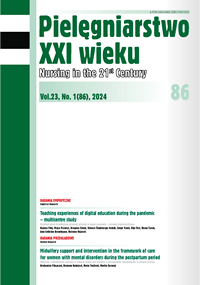The importance of knowledge of the fundamentals of proper psychosexual development in nursing practice, including aspects related to autosexual behaviour – the role of nurses in sexual education
DOI:
https://doi.org/10.2478/pielxxiw-2024-0007Keywords:
sexology, girls, gynaecologyAbstract
THE IMPORTANCE OF KNOWLEDGE OF THE FUNDAMENTALS OF PROPER PSYCHOSEXUAL DEVELOPMENT IN NURSING PRACTICE, INCLUDING ASPECTS RELATED TO AUTOSEXUAL BEHAVIOUR – THE ROLE OF NURSES IN SEXUAL EDUCATION
Introduction. Sexology is defi ned as the scientifi c study of human sexuality, including its development, behaviour, functions and preferences. A lot of gynaecological problems are linked to sexual development. Development of the sexual organs is strictly associated with the function of the hypothalamic-pituitary-adrenal axis.
Conclusion. The aim of the study was to emphasize the importance of nursing care in sexual education on the example of masturbation of children. Paediatric and adolescent gynaecology is a multidisciplinary fi eld. Gynaecological problems among children and adolescents are often complex, both in terms of medicine and psychology, and require an interdisciplinary approach, including nursing care.
References
1. Robbins CL, Schick V, Reece M. Prevalence, frequency, and associations of masturbation with partnered sexual behaviors among US adolescents. Arch. Pediatr. Adolesc. Med. 2011; 165(12): 1087-1093.
2. Jakubek E, Jarząbek-Bielecka G, Boroch J, et al. Autosexual behavior as a topic for inclusion in gynecological practice. Clin. Exp. Obstet. Gynecol. 2021: 48(2): 212-215.
3. Nass G, Fisher MP. Sexual Choices. Jones and Bartlett Publisher, INC. Boston; 1987.
4. Nawrot-Borkowska M. A Secret Sin. The Issue of Children’s Sexuality, Considered in the Light of Handbooks from the Second Half of the 19th Century and the Early 20th Century. EETP. 2016; 1: 79-100.
5. Jarząbek G. Childhood sexuality in childhood and adolescent gynecology. Role Freud: psychoanalise. Gin. Prakt. 2006; 3: 16-23.
6. WHO. Sexual health and its linkages to reproductive health: an operational approach. Geneva 2017: World Health Organization. Available at: https://www.who.int/reproductivehealth/publications/sexual_health/sh-linkages-rh/en/ (Accessed: 1 August 2020).
7. Baumeister RF, Twenge JM. Cultural suppression of female sexuality. Review of General Psychology. 2002; 6: 166-203.
8. Laumann EO, Paik A, Rosen RC. Sexual dysfunction in the United States: prevalence and predictors. Journal of the American Medical Association. 1999; 281: 537-544.
9. Rosen C, Brown Heiman J, Leib SR. The Female Sexual Function Index (FSFI): a multidimensional self-report instrument for the assessment of female sexual function. Journal of Sex & Marital Therapy. 2000; 26: 191-208.
10. Pastwa-Wojciechowska B, Izdebski B. Sexual activity of Polish adults. Annals of Agriculture and Environmental Medicine. 2014; 21: 194-197.
11. Plagens-Rotman K, Jarząbek-Bielecka G, Merks P, et al. Disability vs the sexual life of women - selected issues. Clin. Exp. Obstet. Gynecol. 2021; 48(1): 19-23.
12. Nowak M, Gawęda A, Janas-Kozik M. Physiological psycho-sexual development of children and adolescents. Seksuologia Polska. 2010; 8(2): 64-70
13. Boroch J, Jarząbek-Bielecka G, Mizgier M, et al. Sexuologic and gynecologic problems in childhood and adolescence girls. Pediatr. Endocrinol. 2019; 66: 17-22.
14. 14 Plagens-Rotman K, Przybylska R, Gerke K, et al. Genital herpes as still signifi cant dermatological, gynaecological and venereological problem. Post. Derm. Alerg. 2021; 38(2): 210-213.
15. 15 Robbins CL, Schick V, Reece M. Prevalence, frequency, and associations of masturbation with partnered sexual behaviors among US adolescents. Arch. Pediatr. Adolesc. Med. 2011; 165(12): 1087-1093.
16. 16 Plagens-Rotman K, Przybylska R, Gerke K, et al. Acute form of acne inversa in an 18-week pregnant patient: a case study. Post. Derm. Alerg. 2019; 2: 242-246.
17. 17 Plagens-Rotman K, Przybylska R, Adamski Z, et al. Skin and mucous membranes’ manifestations of dermatological diseases within the genital area in females. Post. Derm. Alerg. 2018; 2: 199-203.
18. 18 https://psychologiawpraktyce.pl/artykul/seksualnosc-malych-dzieci (data wejścia 04.09.2021 godz. 17.39)
19. 19 Beisert M. Rozwojowa norma seksuologiczna jako kryterium oceny zachowań seksualnych dzieci i młodzieży. Dziecko krzywdzone. Teoria, Badania, Praktyka, 2006; 16: 66-80.
20. 20 Beisert M. Kryteria diagnostyczne przydatne dla oceny zachowań seksualnych małego dziecka. Przegląd Seksuologiczny. 2008; 2: 11-19.
21. 21 Brilleslijper SN, Baartman HEM. What do young children know about sex? Research on the sexual knowledge of children between the ages of 2 and 6 years. Child Abuse Review. 2000; 9: 166-182.
22. 22 Bolton FG Jr, Morris LA, MacEachron AAE. Males at risk: the other side of child sexual abuse. Beverly Hills CA: Sage; 1990.
23. 23 Barton D. Schmitt, author of My Child Is Sick, American Academy of Pediatrics Books. Published by RelayHealth. McKesson Corporation, 2014.
24. 24 Boroch J, Jarząbek-Bielecka G, Mizgier M, et al. Infantile and early childhood masturbation and adult masturbation. Med. Rodz. 2018; 1A: 80-82.
Downloads
Published
Issue
Section
License
Copyright (c) 2024 Authors

This work is licensed under a Creative Commons Attribution 4.0 International License.




